
Station Name: HELLESDON
Looking south-east from Hellesdon Road bridge towards Norwich in the summer of 1973. The demolition train which started at Norwich City has reached the 'A' frame bridge over the river Wensum and is slowly and relentlessly inching its way towards Hellesdon station.
Photo copyright Gill Wright / Norfolk Railway Heritage Group  Class 03 shunter No.2014 is viewed from bridge No.250 with the demolition train, working its way north from Norwich City. Between the locomotive and brake van is the 'shunter runner'; these were former 'Conflat' container flats and from the late 1960s were semi-permanently coupled to these relatively small shunters to aid track circuit operation. In the centre background, above the brake van, Hellesdon's goods dock can be seen while the houses in the distance are part of New Costessey. This and the following photographs of the demolition train all came undated but investigations reveal they were taken over the course of a few hours one day during the summer of 1973. The line south of Drayton had become disused in 1969 and by 1971 the Lenwade - Drayton section had also been closed but the running line left in situ to gradually become overgrown while it awaited the demolition train. Class 03 No.2014 was new to Cambridge shed in March 1958 but during her career spent time at other sheds in East Anglia before finishing her working life at Stratford. At the time she was photographed at Hellesdon she was a March resident so had presumably been loaned to Norwich for the work on which she is seen. Technically the locomotive, train and crew were on hire to Thos. W. Ward, the contractor believed to have been engaged to lift the track. No.2014 was originally allocated the number 11201 but this was never carried and she emerged from Swindon Works as D2014 or possibly as D.2014. Under the TOPS system she became 03014 in March 1974, only to be withdrawn three months later. Moved to Doncaster Works, she was stripped of parts and finally scrapped in April 1976.
Photo copyright Gill Wright / Norfolk Railway Heritage Group 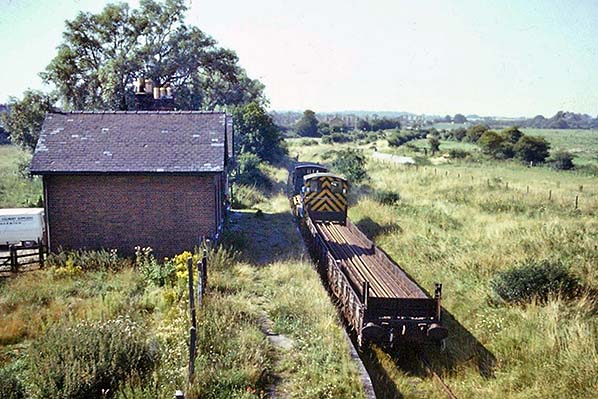
Similar to the previous view, the train has now moved into the station platform and the rails immediately behind it (nearest the camera) are about to be lifted. Not visible in this and the previous view are the crawler crane and trolley-mounted compressor used for the physical removal of the rails; these items of equipment will be lurking behind the camera. Coupled behind the locomotive is a 'Sturgeon' bogie wagon, partially loaded with lifted rails. At extreme left, the Anglian Culinary Supplies van is parked on the station forecourt; the station approach road being on the west side of the bridge and goods yard access being on the east side. After closure of the station in 1952, the building was used for a number of purposes and a base for Anglian Culinary Supplies was one of them. The building was demolished in 1975, along with the bridge which allowed a slight realignment of the road to ease a somewhat awkward bend in its westbound approach.
Photo copyright Gill Wright / Norfolk Railway Heritage Group
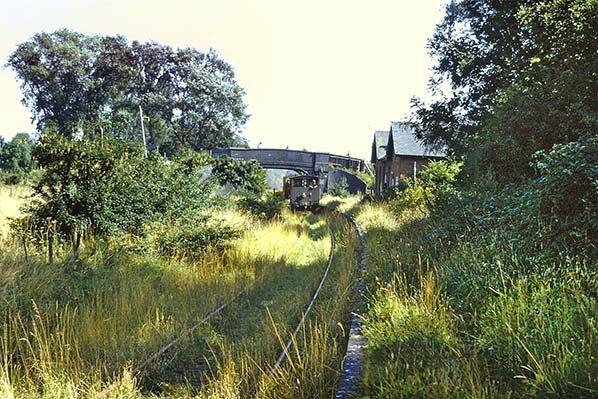
Close examination of the previous two views shows a person standing at the extreme north end of the station platform and this is the scene he photographed. Beyond the bridge, ie on its southe side, the rails had been lifted and the section through the platform is about to be tackled. The rail heads are polished due to the demolition train repeatedly passing over them as it takes wagons loaded with rails northwards and then returns with an empty. As can be deduced, it was necessary for the locomotive to push the brake van as it worked its way northwards, a lookout being on the verandah accordingly. His main job would be looking for obstructions on the track which, due to undergrowth, may not be visible to the driver. Trains moving over disused sections of track were and still are restricted to a maximum speed of 15mph. Just visible beneath the bridge are two of its ornate spandrels - see other photographs for a better view. Hellesdon signal box once stood on the platform, near the point where sunlight meets shadow. Details of the box, which had been replaced by a ground frame and eventually demolished just prior to WWII, can be found elsewhere.
Photo copyright Gill Wright / Norfolk Railway Heritage Group 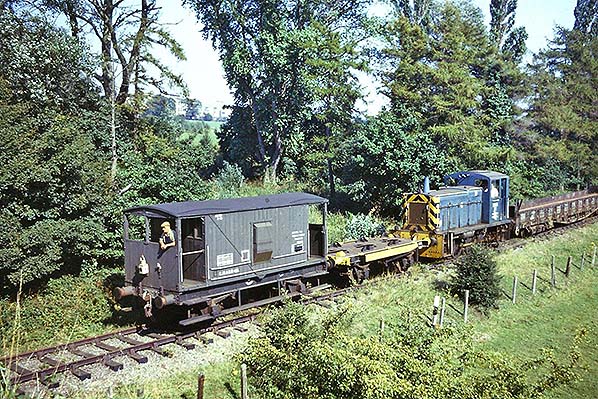
This view is out of sequence but it is convenient to position it so. The location is south of Hellesdon Road bridge and the train is approaching the station (it is moving right to left), having previously crossed the by-now-trackless 'A' frame bridge near an area known as Sloughbottom. The brake van is of LMS origin and to a design which originated with the Midland Railway. The van is allocated to CM&EE (Chief Mechanical and Electrical Engineer) use and is branded 'Return to ....' but although the location appears to include Norwich the name is largely unreadable. Of the 'shunter runner' truck between brake van and locomotive, the yellow board on its side should be lettered 'Shunter Runner' or 'Shunting Runner' along with its number and depot name but this example appears to be completely blank or badly faded.
Photo copyright Gill Wright / Norfolk Railway Heritage Group 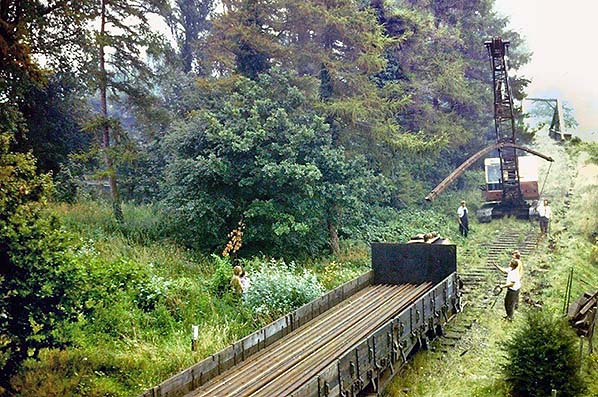 With the station behind the camera, this view is looking towards Norwich City. In the background stands the famous 'A' frame bridge; one of two such bridges on this section of the former M&GN it is still standing today as is the second example located just south of Drayton. The contractor's crane, a Ruston Bucyrus 22RB, is loading rails onto the wagon. Sharp-eyed readers will notice this is a different wagon to the Sturgeon seen previously. The Sturgeon has been loaded and taken away, the locomotive returning with this LNER-designed 'Dolphin' wagon. Perhaps more familiar from the GWR, many wagons were given names of various species of animal life and the names were used as telegraphic codes to simply identities. Today the practice is all-but obsolete on the National Network. Just behind the Dolphin is the compressor on a lightweight engineers trolley; this would have been powering a pneumatic spanner for removing fishplate bolts. It will be noted that only rails are being lifted; chairs and sleepers would have been removed subsequently using road vehicles. The method of operation is fairly obvious. The train would have drawn forward one track panel at a time while the preceding panel had its rails removed and craned into the wagon, this method being necessary due to the single track formation which also precluded the use of more than one wagon. The contractor and BR would have set up a base somewhere, possibly at Lenwade, to where the loaded wagon would have been taken and another, empty, collected to take its place. This operation would be repeated until a train load of lifted rails was assembled and then removed from the branch. When a wagon change was required, the compressor and its trolley would be left on site. Note the youngsters, no doubt locals, watching the operation on the left and the almost total lack of what we now know as Health & Safety regulations.
Photo copyright Gill Wright / Norfolk Railway Heritage Group 
With the two youngsters still looking on, the crane is now lowering two rails, which just minutes previously had had the train pass over them, into the wagon. One of the men on the right is holding the pipe from the compressor, ready for the train to draw forward and the next pairs of fishplates unbolted. Quite what is being done with the fishplates and bolts at this stage is unclear. The Dolphin wagon carries a DB prefixed number, meaning it is a departmental (engineers) vehicle - the very purpose for which these vehicles were designed. The wagon carries markings which show it is, or at least had been, allocated to Blackpool, a very long way from Norfolk. Curiously, although 'Blackpool' can be seen clearly enough on the original photograph the word next to it is less clear but appears to say 'Cent.' meaning Blackpool Central, a large station with shed and other facilities which had closed
back in 1964. Photo copyright Gill Wright / Norfolk Railway Heritage Group
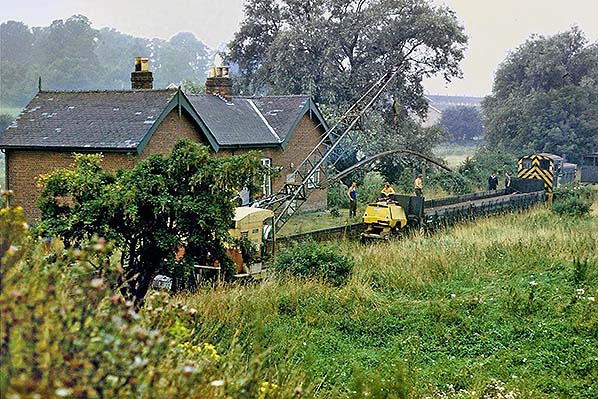
A more broadside view of the operation, the lifting of the rails now having reached a point midway through the platform. As we have seen, while the team were at Hellesdon it had been necessary to despatch a loaded wagon and return with an empty and the line through Hellesdon station would have become devoid of rails in a space of about two to two-and-a-half hours. Unfortunately the Ruston Bucyrus 22RB crawler crane is partly obscured but we are offered a slightly better view of the compressor mounted on a lightweight engineers trolley. Also visible is the alteration made to one window of the station building, that one the right, giving the platform frontage an asymmetrical appearance. The building's gables were typical M&GN, the same general design also being found on many of the Company's signal boxes.
Photo copyright Gill Wright / Norfolk Railway Heritage Group 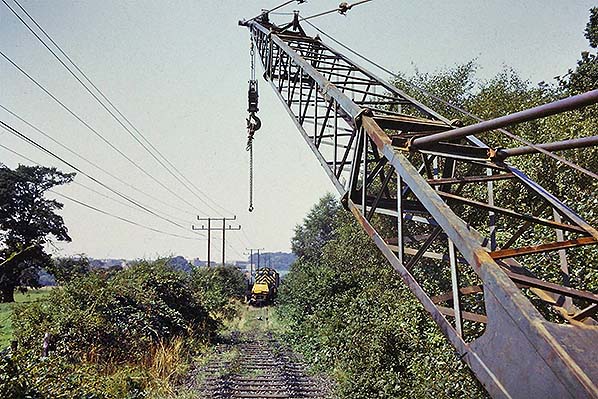
The impression given by this view is that the crane had deliberately moved back to allow this photograph to be taken. We know by the lifted rails and position of the train that the camera is facing north, but the precise location is difficult to determine. The routing of the overhead power lines and their proximity, at this point, to the railway would suggest the location is to the north of station and just south of the point where what is today Leewood Crescent, New Costessey, backs onto the former railway, now Marriott's Way footpath. Irrespective of the precise location, this and the previous views bear witness to what was the very last train to traverse the Norwich City - Lenwade section of the former M&GN.
Photo copyright Gill Wright / Norfolk Railway Heritage Group  With the exception of the young person on the left, it is not easy to tell in this view who is a worker and who is merely an onlooker. The presence of a train at Hellesdon following four years of slumber would no doubt have been an attraction for many local people. The crane is loading the rails which minutes previously the train would have trundled over for the last time. The crane is in the standard red and cream livery applied by the manufacturer if no other livery was requested; an attractive livery, it was not far removed from the livery once applied to British Railways road vehicles. The Ruston Bucyrus 22RB (or 22-RB) could be supplied in several forms to suit customer requirements, with one of the common versions being the crawler crane as used at Hellesdon. Most used the Ruston 6YDA air-cooled diesel engine producing 125bhp at 2000rpm. The use of this engine was the reason why, during hot weather, the rear doors were frequently left open. Doors, plural, is correct as there were two sliding doors at the rear. Capacity depended upon specification but was generally 15 tons. On the rear, below the open doorway, was fixed a large Ruston Bucyrus (pronounced Bew-cy-rus) nameplate. When new the lettering of these plates was picked out in a light colour, cream or white, but on this example the plate, let alone its lettering, is barely visible
Photo copyright Gill Wright / Norfolk Railway Heritage Group 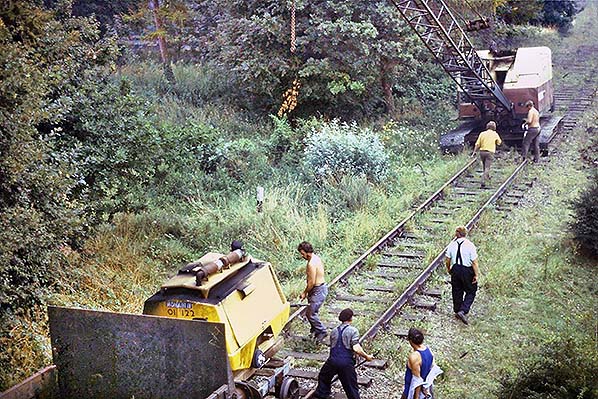
A closer view of the track lifting gang at work on what was clearly a rather warm day in 1973. The shirtless man on the left will have walked along the track panel knocking out the rail keys (wood or steel devices which held the rails securely within the chairs) while the man wearing a cap, bottom centre, is about the bar the rails loose from the chairs. In theory, once fishplates have been removed and keys knocked out, rail should then be free but in practice rust could bond rails and chairs together, hence a need to bar them free. This done, the track panel between train and crane will have its rails lifted and despited in the Dolphin wagon, bottom left. The compressor is sitting open a somewhat ancient trolley constructed of flitched wood. The trolley appears to be the type with which the frame simply sat astride the axles via simple bearings and could be lifted off the track by a couple of men but not, of course, with the compressor present. The frame of the trolley is exactly that - a frame and it appears its deck, or floor, has largely disintegrated. The compressor is sitting on longitudinal timber baulks, themselves resting on what remains of the trolleys transverse planks. The trolley probably belonged to the contractor and will have trundled, one track panel at a time, from Norwich all the way up to Lenwade. The compressor itself has had its road wheels removed, perhaps to avoid theft while it sat unattended overnight but more likely to facilitate ease of craning on and off the trolley
by means of a sling. Photo copyright Gill Wright / Norfolk Railway Heritage Group
1.jpg) Looking north-west during the demolition of the station building at Hellesdon in 1975. Looking north-west during the demolition of the station building at Hellesdon in 1975.Photo from Stuart McPherson's Flickr Photostream Click here for Hellesdon Station Gallery 4:
|

 Home Page
Home Page